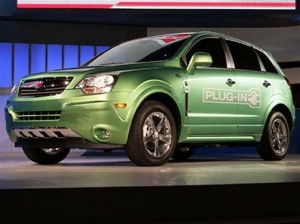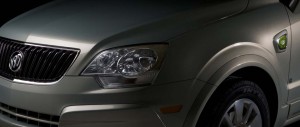
GM needs a new home for what was to have been the Saturn Vue Plug-In Hybrid. Plans to give it to Buick were scrapped and it may now go to Chevy -- or GMC or Cadillac.
When General Motors eliminated half its brands, essentially overnight, it created some significant turmoil in its product development program. For one thing, the sale of the Saturn division meant there’d be no home for the plug-in hybrid system that was supposed to be used on the brand’s 2011 Vue.
GM officials briefly considered giving a thinly revised version of the Vue plug-in to Buick, one of the company’s four surviving North American brands, but pulled the plug on that idea, as well. But, sources confirm for TheDetroitBureau.com, the technology won’t be abandoned, and while a final decision on where to use it has not been made, it will almost certainly show up in a Chevrolet or GMC model, most likely by the originally-planned, 2011 model-year.
Like many of its competitors, GM is pushing heavy into “electrification,” the use of battery-powered hardware to either supplement or replace the time-tested internal combustion engine. The well-publicized Chevy Volt is the prime example of this concept. Though often casually described as a plug-in, Volt is actually an extended-range electric vehicle, or EREV. The difference is subtle but significant, in that Volt’s wheel are always driven by electric motors. Its lithium-ion battery pack has a suggested range of 40 miles, and after that, the EREV’s inline-four gasoline engine fires up – but only as a generator, giving it essentially unlimited range.

Plans to give this Saturn Vue-based crossover, including a plug-in hybrid powertrain, to Buick were nixed, last month.
The technology intended for the Saturn Vue Plug-in is initially similar to the familiar Toyota Prius hybrid, but it’s also able to operate at greater speeds and longer distances – up to about 10 miles – solely on battery power. As with Volt, its I-4 engine will also fire up when the batteries are drained, but like Prius, the gasoline side of the powertrain can drive the wheels directly.
The development program has been complex and costly, stressed one of several sources willing to discuss the program, only some of whom would be quoted directly. For his part, GM spokesman Pat Morrissey added that, “anything we can do to keep the project going without significant (additional) investment would be good.”
Morrissey noted that GM’s new director of product development, Tom Stephens, has said he wants to find a new home for the plug-in system. Troy Clarke, president of GM North America, until the automaker emerged from bankruptcy, in July, thought he had found just such an opportunity, re-badging the plug-in Saturn crossover vehicle as a Buick.
In fact, Stephens revealed that plan during a speech at an industry conference, in Traverse City, Michigan, last month, and GM then showed a prototype to a group of automotive journalists later in August. But the reaction was generally negative – both inside and outside of the company, one source noted, and with its champion, Clarke, leaving GM, the Buick plug-in program was scrapped.
But there are other opportunities, GM is betting, and that could land a version of the vehicle at one of the other three North American divisions, Chevy, Cadillac or GMC. “Most likely,” said Morrissey, the technology would remain on either the Theta-based Vue “architecture,” or a similar compact crossover platform, because that would minimize preparation costs.
There are three existing variants that could readily accept the plug-in drivetrain, including the new and well-received Chevrolet Equinox, the GMC Terrain or the second-generation Cadillac SRX. It is also possible GM could simply follow the same strategy it was going to use for Buick, and make only the most modest cosmetic changes to the old Saturn Vue and sell it through one of the other three divisions.
Though the General Motors spokesman cautioned that, “We have not made the final call,” several sources said Chevrolet is the leading candidate to get the plug-in system. By far the largest of the surviving GM brands, Chevy hopes to use Volt – and possibly other “green” powertrain technology – to make a frontal assault on its Asian arch-rival, Toyota, which has positioned itself as the environmentally-friendly automaker.
A final decision is expected quite quickly, all sources agree, for as spokesman Morrissey noted, “The hope is to schedule it to be built as soon as the Saturn” was originally planned, which would have been the 2011 model-year.
